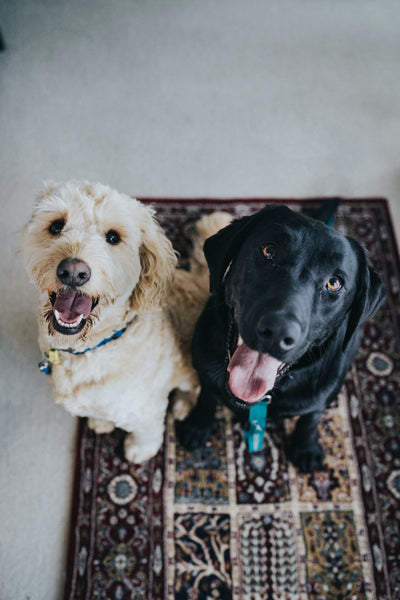With more than a year of social distancing behind us, many of us are eager to get back to socializing with loved ones. The excitement of socializing may also come with some anxiety—do we even remember how to be social? Do our dogs remember their social skills? Have our pandemic puppies missed their socialization window?
What is Socialization?
Socialization is, essentially, exposure to different experiences, situations, people, and animals. When you socialize your dog, you are preparing him to feel confident and have positive experiences in various environments and social settings.
It’s important to socialize your pooch whether he’s a puppy, adult, or senior. Dogs who are lacking proper social skills are more prone to anxiety and aggression, while properly socialized dogs tend to be more well-adjusted; they’re more approachable, happier, and less stressed.
With each positive new experience, your dog will feel more confident about exploring the world, people, and animals around him. When you expose your dog to different sights, sounds, and scenarios, it’s especially helpful if you remain calm and happy, and even associate a potentially scary experience with something positive such as treats or toys.
Important exposures include:
-
Surfaces and textures (grass, leaves, carpet, concrete, dirt, wood, etc.)
-
Sounds (such as doorbells, phones ringing, vacuum cleaners, car horns, other dogs barking, and thunderstorms)
-
Other dogs (neighborhood dogs, dogs at the dog park, or other pets in the house)
- Other people (household members, mail carrier, friends and family, strangers you encounter on walks)
Ideally, a dog would be socialized between the ages of eight weeks and four months old. Fortunately, you can still teach an old dog new tricks regardless of age, especially with these helpful tips.

Be Realistic
Depending on your dog’s history, health conditions, or general demeanor, you may have to come to terms with the fact that your furry friend simply isn’t going to be the most popular pup at the dog park who embraces every social encounter.
Instead, focus on helping your dog become comfortable enough to feel happy and secure with new people, animals, and experiences. The less stress and anxiety he experiences in his everyday life, the better.
Start Slowly
Too much exposure too fast can be overwhelming. Instead, focus on one new experience at a time and even then, start small.
For example, if you want your pup to meet other people, start by introducing him to one or two new people at a time and gradually increase from there. If your dog feels bombarded by a large group of people and has no way to escape, his anxiety may turn to aggression as a form of self-defense.
Instead of jumping right to the dog park, start by going on daily walks—just you and your pooch. Once he’s comfortable walking past strangers and other animals, you can try a one-on-one playdate with a friend or neighbor’s dog. After Fido feels secure and confident around others, you can bring him to the dog park or doggy daycare for the ultimate socialization experience.
Stay Calm
If you’re in a social situation and tensions start to rise, it’s crucial to remain calm and in control. Dogs can sense our emotions so if you’re stressed, he may feel that his anxiety is justified which will only escalate the situation.
If you sense that your dog is feeling uncomfortable, calmly remove yourselves from the situation until it has deescalated. Some dogs find it therapeutic to go through a routine of familiar commands rewarded with some treats.
For the sake of safety, be sure to follow all leash policies—especially if your pup’s nerves make him unpredictable.

Reward Positive Behavior
Create a positive association with new people and experiences using treats. After all, a dog who knows a treat may be in his near future is much more likely to cooperate and feel excited about meeting someone new.
Let your dog know you appreciate his progress by praising his good behavior after any positive encounter. You’re his best friend, so of course your approval is going to be a strong incentive.
Explore Different Settings
The more comfortable your dog is with the world around him, the more comfortable he’ll feel around other animals and people. We know dogs love routines, but it’s also important to switch it up every once in a while to keep him open to new experiences.
Go on daily walks, visit dog-friendly outdoor restaurants and cafes, try different outdoor activities such as hiking and biking, or take your dog on car rides while you run quick errands to help him experience new sights, smells, and sounds.
Allow Alone Time
It may seem counterproductive, but teaching your dog to be comfortable on his own is an important aspect of socialization. If he feels safe and secure no matter where he is or who he is or isn’t with, he’ll be much less likely to experience separation anxiety.
Consider implementing crate training as part of your dog’s structured routine. Not only will this help him learn to be fine on his own, it can also create a safe place to escape to whenever he’s feeling a bit too overwhelmed.
For dogs who experience separation anxiety or get stressed during new experiences, PetHonesty’s Premium Hemp Calming Chews use natural ingredients to calm and soothe an anxious dog.
If your dog is experiencing chronic stress, anxiety, or behavioral issues, talk to your vet to rule out any underlying health conditions. It may also be wise to consult a professional dog trainer to address any serious behavioral concerns.
Sources:
https://www.preventivevet.com/dogs/how-to-help-adult-dog-with-socialization
https://naturaldogowner.com/why-its-never-too-late-to-socialize-your-dog/
https://www.rover.com/blog/how-to-socialize-dog/
https://www.akc.org/expert-advice/training/socialize-puppy-times-social-distancing/













